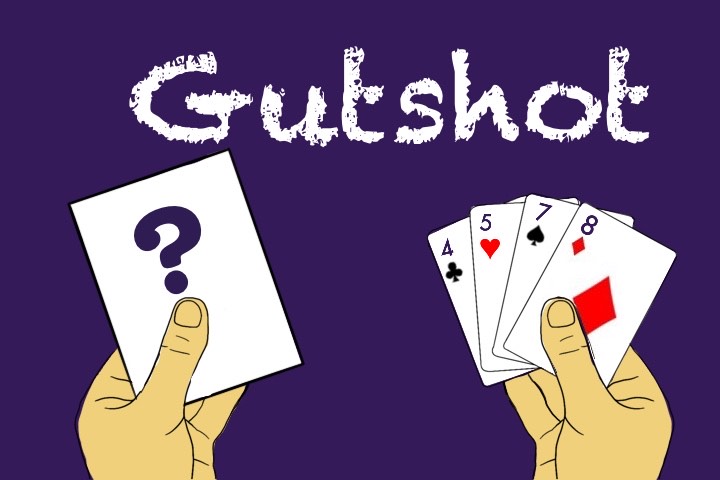A gutshot poker straight is one of the common terms you will hear or read about when watching or reviewing a hand history.
Actually hitting a gutshot straight can be an exhilarating experience – especially for casual players who are anxious to take down a big home game pot against their buddies. Hitting a gutshot can even result in a massive positive swing for regular players who frequent their favorite retail card rooms.
But beware. Chasing gutshot straight draws can also become a major leak in your poker game.
Read on to find out more about gutshot straights, how they’re “made,” how they’re “missed,” and why one should consider showdown equity when holding a gutshot straight draw in poker.

What is a Gutshot in Poker?
A “gutshot” in poker is an inside straight draw.
In flop games such as Texas Hold’em and Omaha, Draw Poker games, and Stud games, players and commentators typically make reference to a gutshot when someone is drawing to a “four-outer” straight.
Here’s an example from Hold’em:
Player 1: Js-6d
Community Board Cards: Qd-9h-8s (?) (?)
On the flop, Player 1 is looking to make a hand but is currently holding “air” (a term used to describe a hand that is worse than One Pair).
If players’ hole cards were revealed at this point in the hand, Player 1 would have a Queen-high nothing.
But… if a ‘10’ is dealt on the Turn or River, Player 1 will have hit an inside (or gutshot) straight.
Community Board Cards: Qd-9h-8s-Tc (?)
Now, Player 1 has made a Straight and can use the Jack of Spades hole card to complete a relatively strong 5-card poker hand.
Let’s look at another example.
Player 1: As-7d
Community Board Cards: 5d-Js-6h-9h (?)
On the Turn, Player 1 can’t beat any made hand, and has a gutshot Straight draw that requires an ‘eight’ (and only an ‘eight’) to complete. With no other known information about the hand, Player 1 has exactly four outs that will complete the gutshot Straight draw – 8d, 8s, 8h, and 8c.
This pretty much sums up the gutshot poker meaning. It’s an inside Straight draw.
The odds of actually making a Straight from a gutshot draw are twice as bad compared to an “open-ended” Straight draw.
Player 1: 9h-8c
Community Board: Ah-7c-6d (?) (?)
In this example, Player 1 has flopped an “open-ended” Straight draw (not to be confused with a “gutshot” Straight draw). With no other known info on the hand, Player 1 has exactly eight outs to complete a 5-card Straight.
If one of the four remaining Fives or one of the four remaining Tens is dealt on the Turn or River, then Player 1 will have completed a Straight.
What is a Double Gutshot in Poker?
If you’ve watched poker on TV or a live stream, chances are you’ve heard the term “double-gutter” or “double-gutted” to refer to a double gutshot Straight draw.
So what is a double gutshot or double-gutter in poker? Let’s take a look at an example below.
Player 1: Jh-7s
Community Board Cards: Qc-9d-8h-5s (?)
In this example, Player 1 needs one of eight remaining cards to make a Straight: one of the four remaining Tens for a Queen-high Straight (Q-J-T-9-8) or one of the four remaining Sixes for a Nine-high Straight (9-8-7-6-5).
Here’s one more look at a double gutshot Straight draw.
Player 1: Ah-4d
Community Board Cards: 5s-3c-7h (?) (?)
On the flop, Player 1 is “double-gutted,” which is to say that Player 1 has a double gutshot Straight draw.
Any Two would give Player 1 a “wheel,” or a Five-high Straight (5-4-3-2-A). Any Six would give Player 1 a Seven-high Straight (7-6-5-4-3).
Are Gutshot Straight Draws Vulnerable in Poker? Even If They Hit?
Yes. Gutshot straight draws in poker can be very vulnerable to a superior “made” hand at showdown… even if the player possessing the draw manages to “hit” the Straight in question.
If we take a quick look at the Poker Hands Ranked page, we’ll find that there are quite a few hands that will outright defeat any Straight at showdown.
Let’s use the example from above to illustrate how even a “made” gutshot Straight draw can lose at showdown or even be “drawing dead” after a seemingly miracle Turn card.
Player 1: Ah-4d
Player 2: 9h-8h
Player 3: Ks-Kc
Community Board Cards: 5s-3c-7h-6d (?)
On this Turn, Player 1 has successfully completed a Straight upon hitting one of the eight “outs” to convert a double gutshot Straight draw into a made hand.
However, Player 1 and Player 3 are now drawing dead on the Turn – because Player 2 has simultaneously made a better Straight (or the “nut” Straight in this case).
If these three players go all-in on the Turn and the hole cards are placed face-up, Player 2 is 100% guaranteed to win the pot outright.
Regardless of what card is dealt on the River, Player 2 will have (at the very least) a Nine-high Straight. It is now impossible at this point for Player 1 or Player 3 to “catch up” to compete with Player 2’s made hand.
If an ‘8’ happens to land on the River, Player 1 WILL improve to an Eight-high Straight, but it will still lose to Player 2. The same can be said for Player 3… if a King is dealt on the River, the made “3-of-a-Kind” hand is still no good against Player 2’s Nine-high Straight.
Should You Bluff with a Gutshot Straight Draw in Poker?
For readers who have frequented online forums or watched a lot of televised poker, you may have noticed the term “showdown equity” being used when players are considering a bluff.
One way players and onlookers observe “showdown equity” is by considering the amount of cards (or “outs”) that a player may have to still win at showdown if a bluff is called.
Again, let’s take a look at a hypothetical sample hand:
Player 1: Kd-9d
Player 2: Jh-Js
Community Board Cards: Ah-Jd-Ts-7d (?)
In this example, Player 1 has Turned a double gutshot Straight draw while also getting closer to completing the “backdoor” Flush draw that was flopped.
However, Player 2 flopped a “set” of Jacks and may not fold the hand if Player 1 decides to bet or go “all-in” on the Turn.
So, for argument’s sake, let’s say that Player 1 “jams” (goes all-in on) the Turn and now it is Player 2’s decision to either call or fold.
Player 1 has eight “outs” to complete the gutshot Straight draw. One of the four remaining Queens will give Player 1 a “broadway,” Ace-high Straight of A-K-Q-J-T while one of the four remaining Eights will give Player 1 a Jack-high Straight of J-T-9-8-7.
But Player 1 also has a Diamond Flush draw to go along with the double-gutter!
This means there are more cards that could give Player 1 a victory at showdown if Player 2 decides to call the all-in:
Q-Q-Q-Q, 8-8-8-8, & 6d-5d-4d-3d-2d
So, statistically speaking, Player 1 has 13 “outs” (from a deck of 44 remaining cards) to win the hand at showdown if Player 2 indeed calls an all-in bet on the Turn.
And while this may not be a “desirable” position to be in for Player 1 (assuming Player 2 does make the call), it’s FAR superior than getting “looked up” (a.k.a., “called”) with only a simple “4-outer” gutshot draw or worse.
Yes, Player 1 will be “behind” in the hand if Player 2 calls the all-in bet on the Turn. But Player 1 can still “suck out” in a variety of ways. In fact, Player 1 WILL win at showdown nearly 30% of the time in this scenario (13 outs divided by 44 remaining cards equals 0.2954 – or 29.54%).
This is what “showdown equity” can refer to… a player’s chance to win with the best hand at showdown – when a bluff on an earlier street (with a then-inferior hand) happens to get called.
Now, let’s change Player 1’s hand to a simple gutshot Straight draw.
Player 1: Kd-4s
Player 2: Jh-Js
Community Board Cards: Ah-Jd-Ts-7d (?)
If Player 1 gets “caught” bluffing all-in on this hypothetical Turn, only one of the four remaining Queens will secure the pot for Player 1 at showdown with a completed “broadway” Straight.
Q-Q-Q-Q
So, Player 1 has only four “outs” from a deck of 44 remaining cards. This correspondingly alters the odds of Player 1 taking down the pot once the River has been dealt.
Four outs divided by 44 remaining cards equals 0.0909 – or 9.09%.
See the difference? The more “outs” Player 1 has on a bluffed Turn, the more “showdown equity” Player 1 possesses.
Of course, this is just one sample hand. And Player 1 will not be aware of Player 2’s holdings, but rather will mentally assign (through estimation) a “range” of hands that Player 2 may possibly have.
This “educated guess” may incorporate multiple variables (such as the opponent’s chip stack, live table demeanor, online action timing, play history, tournament payout structure, cash game stakes, and much more) into an equation that Player 1 can then use to make the best decision about whether to check, bet, raise, or fold.
Are Gutshot Straights Hard to See?
We’ve covered this in another article. Playing card fonts and color schemes DO matter in some cases… especially if an individual is physically or mentally weary, colorblind, or otherwise predisposed to “miss” Straights and Straight draws.
Risking real money on a gutshot Straight draw is one thing. Throwing away real money “expectation” by incorrectly interpreting known information (your hole cards plus any community cards) is something entirely different.
From a poker strategy perspective, it is vitally important for you to correctly interpret any “known info” that the rules of a poker game allow.
If you are unable to identify certain playing card patterns in poker – such as a numerical and/or face-card Straight sequence, for instance – you’re going to be at a clear disadvantage compared to any opponents who CAN correctly interpret the data.
If the Nine of Spades is dealt on the Turn, you need to know that! And – at the very least – you need to know how that relates to the other community board cards as well as your own hole cards (even before you start contemplating your opponents’ “ranges”).
Summary: Gutshot Straights in Poker
Completing a gutshot Straight in poker can be a lot of fun, and can provoke a bit of chagrin from your opponents at the same time. After all, another common name for a gutshot straight draw is a “belly buster”.
However, risking real money on a gutshot Straight draw can be just that… risky.
As a poker player who wishes to improve, it may be a good idea to seek out resources that can assist you on your journey to turning a profit in the games you play.
Being able to grasp fundamental concepts in poker – like the odds of completing a gutshot Straight draw – can be a rewarding experience for beginners who would like to increase their own skill level.
Learn poker through experience by competing against others in your favorite home game, retail card room setting, or online venue – and strive to increase your poker knowledge through said experience.
Whether it’s hitting a four-outer gutshot Straight, “boating-up” through a paired community board, or showing-down an extremely rare Royal Flush, there’s nothing quite like a poker game to simultaneously test your wits and press your luck against other human opponents.
The more you learn about poker, the less you’ll be drawing to an “inside,” or gutshot straight – and the more you’ll be playing with a “made hand” against your opponents. Opponents who have yet to learn the lessons that you’ve already experienced and assimilated through study and actual poker play.
Best of luck hitting your next gutshot Straight draw!




